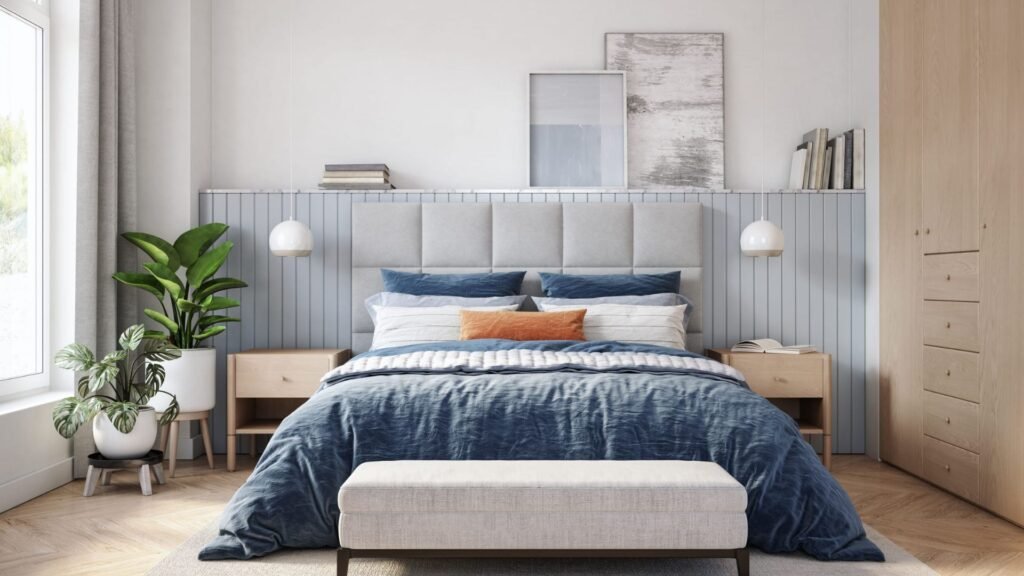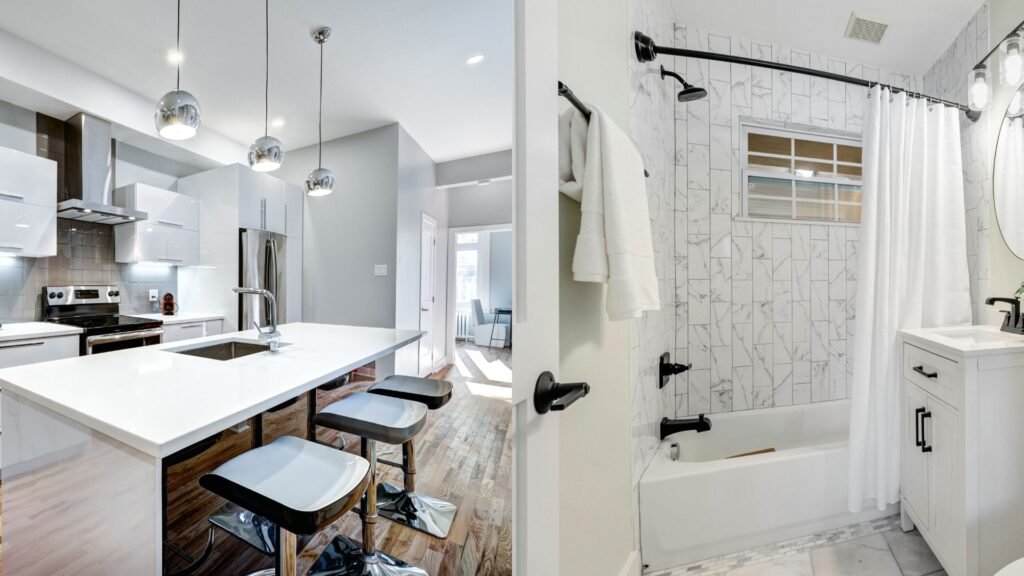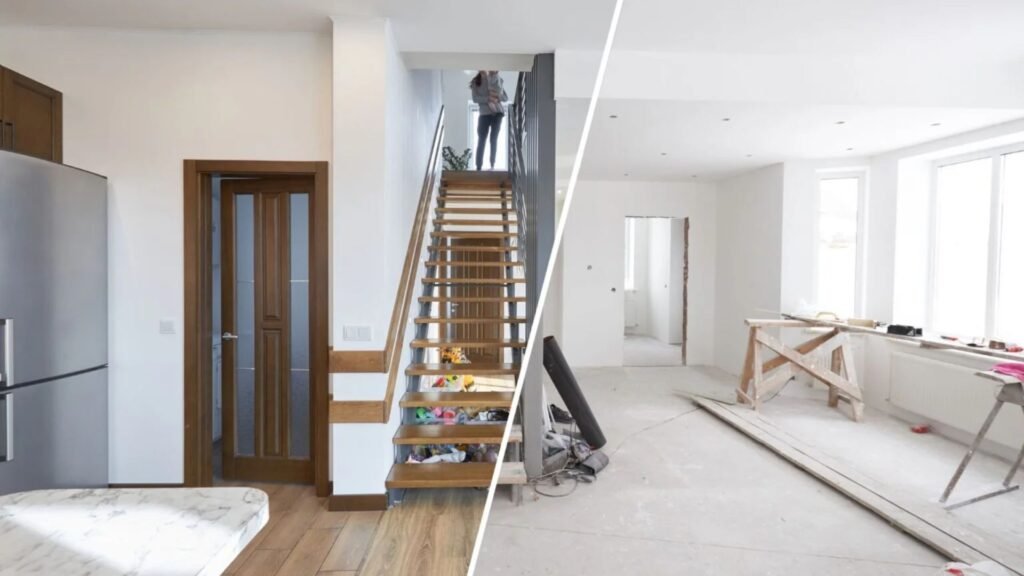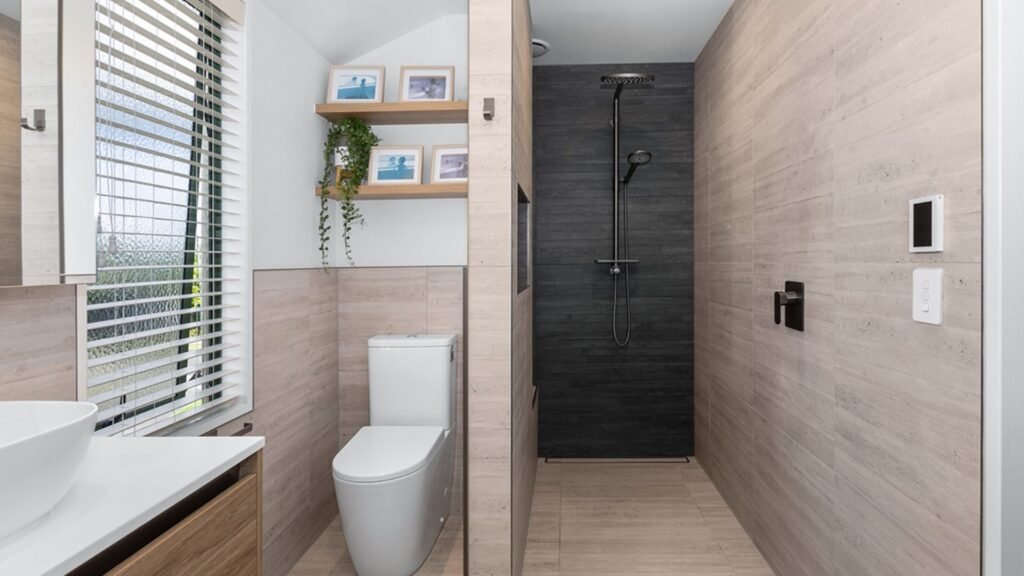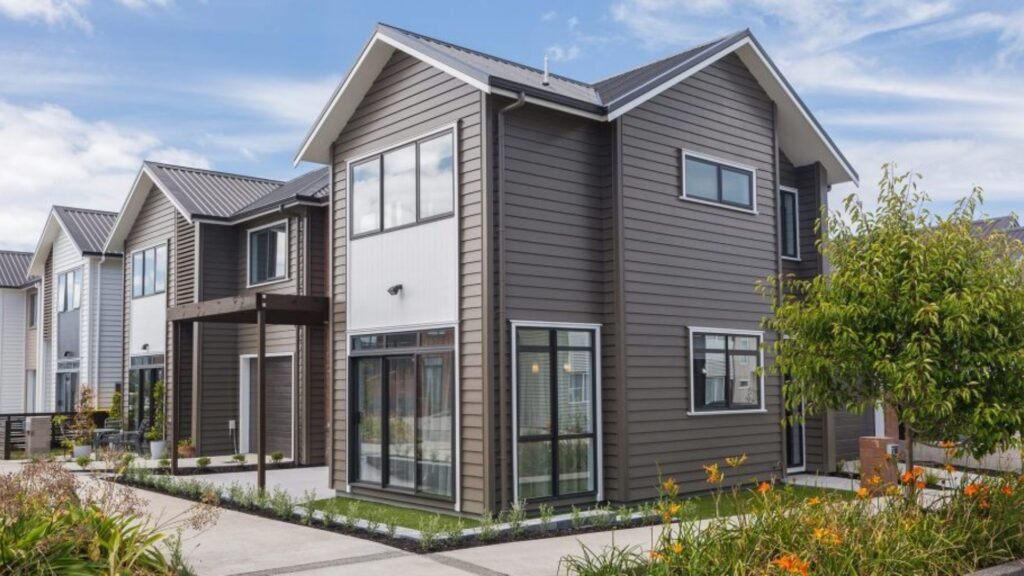Welcome to your go-to guide on bedroom renovation costs in New Zealand. Whether you’re tired of waking up in a space that no longer feels like you or you’re preparing your home for resale, updating your bedroom can make a big difference. But before you start picking paint swatches and flooring options, it’s important to understand how much it could cost, and what factors affect the final price. From small cosmetic updates to full-blown transformations, this guide covers everything you need to know, including average costs, what drives prices up or down, and how to get the best value for your money.
Bedroom renovation cost in NZ typically ranges from $5,000 to $20,000, depending on the size of the room, materials used, and whether you’re doing cosmetic updates or full structural changes. Basic upgrades like painting and new flooring cost less, while custom wardrobes, lighting, and insulation increase the price. Always budget extra for unexpected expenses and labour fees.
Table of Contents
Why Renovate Your Bedroom?
Renovating your bedroom isn’t just about updating how it looks, it’s about improving how it feels, functions, and fits into your daily life. Whether you’ve lived in your home for years or just moved in, your bedroom plays a big role in your comfort and overall well-being. So why do so many New Zealanders choose to renovate their bedrooms? Let’s break it down.
Comfort Comes First
Your bedroom should be the most relaxing space in your home. Over time, it’s easy for the room to feel outdated or no longer suited to your needs. Maybe the layout doesn’t work, the lighting feels harsh, or the insulation isn’t doing its job in winter. Renovating lets you fix those issues and create a space that feels truly comfortable. It could be as simple as adding blackout curtains, soft lighting, or new flooring that feels better underfoot.
Add Real Value To Your Home
Renovating a bedroom isn’t just about your comfort today, it can also boost your home’s value for tomorrow. If you plan to sell in the future, an updated bedroom can appeal to buyers looking for a fresh, move-in-ready space. Features like built-in wardrobes, new paint, modern lighting, and quality flooring all help create a strong first impression. Even minor upgrades can make a difference in how your home is valued.
Life Changes, And So Should Your Space
Maybe you’ve welcomed a new baby. Maybe you’re turning a spare room into a guest space or home office. Or maybe you’re just tired of the same old setup. Whatever your reason, lifestyle changes often call for space changes. Renovating lets you reimagine the room to better fit your current needs. A space that once felt too empty might now need extra storage. Or a room used only for sleeping might need a reading nook or a desk.
Create A Space That Actually Inspires You
Tired of waking up in a space that doesn’t inspire you? You’re not alone. A bedroom that feels cold, cramped, or outdated can affect your mood, sleep, and even motivation. Renovating gives you the chance to make it your own, a room that looks good, feels good, and reflects your personality. From choosing calming colours to installing better lighting, small changes can have a big impact.
The Growing Demand For Functional Bedrooms
More people in New Zealand are investing in bedroom upgrades because of one simple reason: we’re spending more time at home. The rise in remote work and focus on self-care have pushed bedroom comfort to the top of the list. People want spaces that do more than just hold a bed, they want storage, peace, flexibility, and a sense of style. And they’re willing to invest in getting it right.
Renovating your bedroom isn’t a luxury, it’s an investment in your daily comfort and long-term value. Whether you’re after better sleep, more storage, or just a fresh look, a well-planned renovation can completely change how you feel about your home.
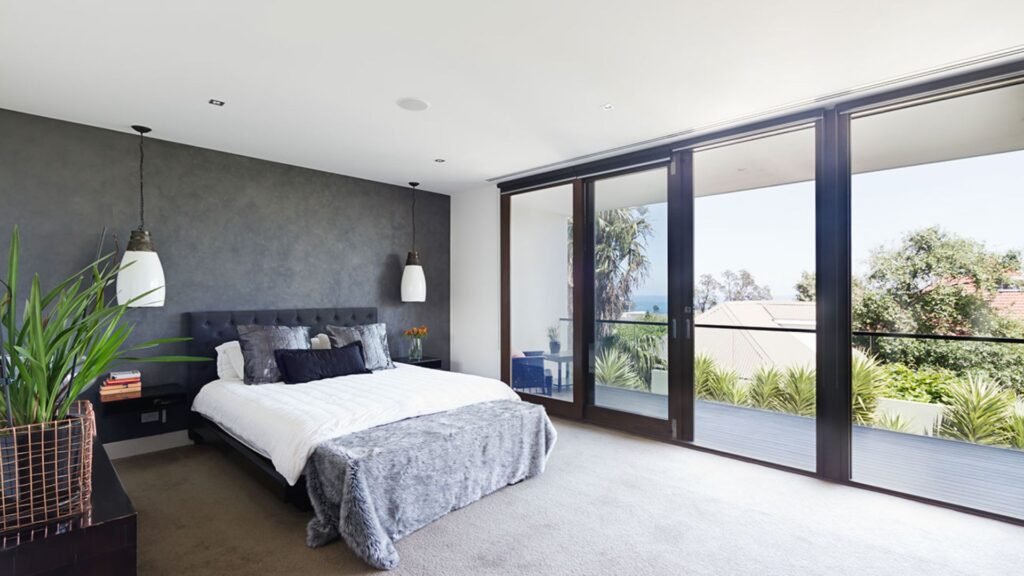
Average Bedroom Renovation Cost In NZ
When planning a bedroom renovation in New Zealand, the first question most homeowners ask is, “How much will it cost?” The answer depends on how much work you’re planning to do, the size of your bedroom, and whether you’re hiring professionals or handling parts of the project yourself.
Small-Scale Renovations
A small renovation, such as repainting the walls, installing new light fixtures, or replacing the carpet, usually falls between $5,000 and $8,000. These upgrades focus on cosmetic changes rather than structural work. This range assumes you’re hiring tradespeople for painting and flooring but may include some DIY elements to cut costs, like removing old carpet yourself or sourcing your own materials.
If you’re comfortable with DIY and only need to pay for materials, the cost could drop closer to $3,000. Just keep in mind that DIY savings often come at the expense of time, effort, and risk of mistakes.
Medium-Scale Renovations
For more involved renovations, such as upgrading wardrobes, installing new flooring, improving lighting, and repainting, the cost typically ranges from $8,000 to $15,000. This level might include minor layout changes or replacing old windows, which require more planning and labour.
At this stage, most homeowners choose to hire professionals. Labour usually makes up 30–50% of the total cost, especially if you’re using licensed builders or electricians. These projects offer a noticeable transformation without getting into the complexity of a full structural overhaul.
Large-Scale Renovations
A full bedroom renovation that includes structural changes, such as adding walls, installing large custom wardrobes, replacing windows, rewiring electrical systems, and adding insulation, can range from $15,000 to $25,000 or more.
This level often requires council approval, building consent, and coordination between multiple trades, like builders, electricians, and painters. These renovations are more common in older homes or when transforming a basic bedroom into a master suite with modern features.
Factors That Can Shift Your Budget
These price ranges are a starting point, your final cost could be higher or lower depending on several things.
- Location: Labour costs in Auckland and Wellington are often higher than in smaller towns.
- Materials: High-end flooring, custom joinery, or imported lighting will push your budget up.
- Unplanned Expenses: Hidden problems like damaged insulation, old wiring, or uneven floors can lead to added costs once work begins.
- Timeline: A rushed job usually costs more due to scheduling pressures or premium labour rates.
Always ask for itemised quotes from contractors so you can see exactly what’s included. This helps avoid surprises and lets you compare prices based on the same scope of work.
Renovation Costs
Renovating your bedroom in NZ doesn’t have to break the bank, but it’s smart to go in with clear expectations. Whether you’re aiming for a quick refresh or a full transformation, understanding the average costs will help you plan smarter, avoid hidden expenses, and create a space you actually enjoy waking up in.
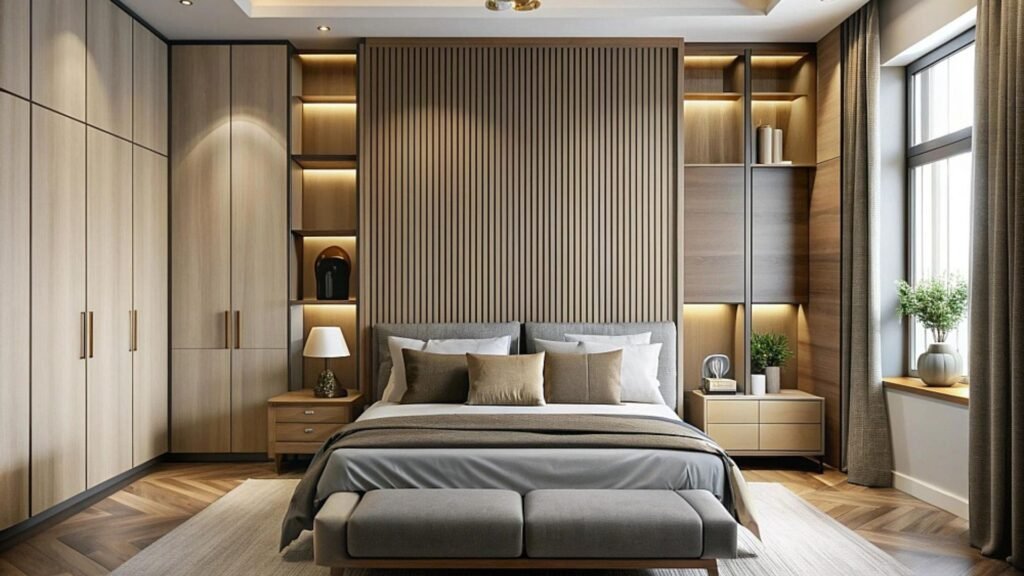
What Affects The Cost Of A Bedroom Renovation?
Renovating a bedroom in New Zealand can range from a few thousand to tens of thousands of dollars. That’s because the cost depends on a mix of factors, from room size to materials to whether you need council approval. Understanding what drives the price up (or down) can help you plan better, avoid hidden costs, and stay within budget.
Size Of The Room
The size of your bedroom is one of the most obvious cost factors. A larger space means more materials and labour. You’ll need more paint, more flooring, more lighting, and potentially larger furniture.
For example, renovating a small guest bedroom might cost much less than updating a spacious master suite. While a 10-square-metre room might only need basic finishes, a 20-square-metre space could double your expenses if you’re doing a full redesign.
Scope Of Work
What you plan to do in the room matters just as much as how big it is. Are you simply giving it a fresh coat of paint, replacing carpet, and upgrading the lighting? Or are you knocking down walls, redoing electrical wiring, and installing built-in wardrobes?
Cosmetic updates are usually more affordable and faster to complete. Structural changes, on the other hand, require more time, more materials, and often more specialist help. The more complex your plans, the higher your total cost.
Materials And Finishes
The quality and type of materials you choose can dramatically change the overall renovation cost. For example:
- Carpet is generally cheaper than timber flooring.
- Standard wardrobes cost far less than custom-built storage.
- Locally made materials are often more affordable than imported options.
If you’re working with a tight budget, opt for durable but mid-range finishes. On the other hand, if you’re investing in a forever home or aiming for a luxury look, expect to pay more for premium selections.
Labour Costs
Labour makes up a significant portion of renovation expenses. You may need to hire multiple professionals just like:
- Builders for structural work
- Electricians for rewiring or adding lighting
- Painters and plasterers for finishing
- Flooring specialists or joiners for custom work
Rates can vary across the country. For instance, labour in Auckland or Wellington is usually higher than in regional areas like Dunedin or Napier. Always get multiple quotes and check for licensed tradies with solid reviews.
Consents And Approvals
In some cases, you might need council approval for your bedroom renovation. If your project involves structural changes, new windows, or alterations that impact the building’s integrity, you may need building consent.
The approval process takes time and often adds to the cost. You may need to hire an architect or draftsperson to submit plans, and there could be extra fees depending on your local council. If your renovation is purely cosmetic, you can usually skip this step, but always check before starting.
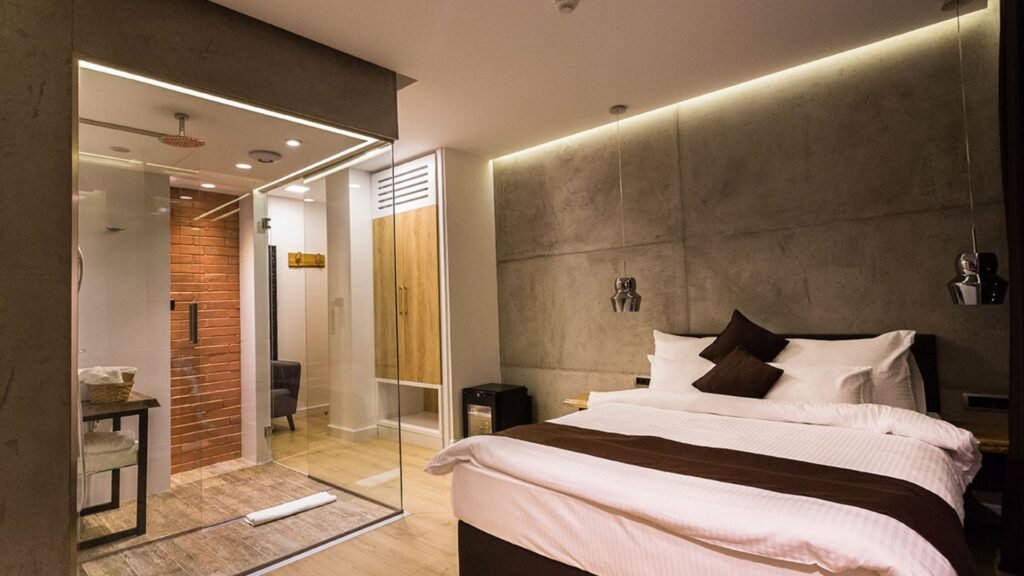
Breakdown Of Common Bedroom Renovation Expenses
Renovating a bedroom in New Zealand involves more than just choosing a new paint colour or throwing in a new bed. Each element comes with its own cost, decision points, and impact on the final feel of your space. Below is a clear breakdown of the most common expenses you should plan for. Whether you’re working with a tight budget or aiming for a luxury upgrade, this section will help you understand where your money goes and where you can save.
Painting And Plastering
Painting is often the first thing that comes to mind during a bedroom makeover. It’s affordable, high-impact, and completely changes how a room feels.
The average cost for painting and plastering in New Zealand is between $25 and $45 per square metre. This includes surface prep, minor repairs, undercoat, and two finishing coats. If the room needs full plastering or major repair work, costs can increase quickly.
DIY painting might save you a few hundred dollars, but if you’re aiming for a smooth, long-lasting finish, hiring a pro is worth the money. Professionals also take care of all the prep work, no sanding, taping, or drop sheets for you.
Flooring
Flooring is another major factor in your bedroom renovation budget. It affects not just the aesthetics but also insulation, noise, and comfort underfoot.
Here’s a quick cost comparison in NZ:
- Carpet: $50–$100 per square metre
- Laminate: $60–$120 per square metre
- Timber: $90–$180 per square metre
- Vinyl: $40–$90 per square metre
Many suppliers offer supply-only or supply-and-install options. Going with supply-only might look cheaper upfront, but DIY installation can lead to expensive mistakes, especially with timber or laminate floors. Always factor in installation labour if you’re not confident doing it yourself.
Lighting And Electrical
Upgrading your bedroom’s lighting can turn it from basic to brilliant. Switching to LED not only saves energy but also adds brightness and a modern feel.
Dimmers, smart bulbs, and ambient lighting options like wall sconces or strip lights range from $50 to $500, depending on style and brand. For electrical work, expect to pay around $70 to $120 per hour for a licensed electrician in NZ.
Don’t overlook safety. Any rewiring or new fixtures must meet current electrical standards. Always use a qualified electrician to avoid compliance issues.
Wardrobes And Storage
A functional wardrobe can make or break the usability of your bedroom. Whether you’re working with a small space or want to upgrade to a walk-in, you’ve got options.
Built-ins are ideal for saving space and boosting property value. Expect to spend $1,000 to $5,000, depending on size and internal fittings.
Standalone wardrobes are cheaper, starting from $300, but may not offer the same efficiency or sleek look. Custom wardrobes offer full control over layout and materials but cost more. Off-the-shelf options are more affordable and faster to install but may not fit your room dimensions perfectly.
Windows And Insulation
Updating windows and insulation helps improve comfort year-round and can reduce your power bills. Double glazing costs around $600 to $1,200 per window but improves warmth and reduces noise. Curtains and blinds vary widely, simple roller blinds can start at $80 per window, while custom-made drapes can run into hundreds. For insulation, expect to pay $2,000 to $3,000 for a full ceiling and wall upgrade in a standard bedroom. It’s a hidden cost that pays off long-term in energy savings and overall comfort.
Furniture And Styling
Styling is where your personality shows. But it can also blow the budget if you’re not careful.
A basic budget for furniture might include:
- Bed frame and mattress: $1,000–$3,000
- Side tables: $150–$400 each
- Dresser or chest: $400–$800
- Decor (art, rugs, plants, lamps): $300–$1,000
To save, consider keeping existing furniture and updating it with paint or new handles. Shop second-hand or browse clearance sections for deals on stylish pieces.
If you’re going to splurge, spend it on the mattress and lighting, two things that directly affect comfort and mood. This breakdown helps you make smarter, well-informed decisions. Planning your bedroom renovation isn’t just about how it looks, it’s also about how it works for your lifestyle and budget. Prioritize the features that matter most to you, and balance big-ticket upgrades with clever, cost-effective touches.
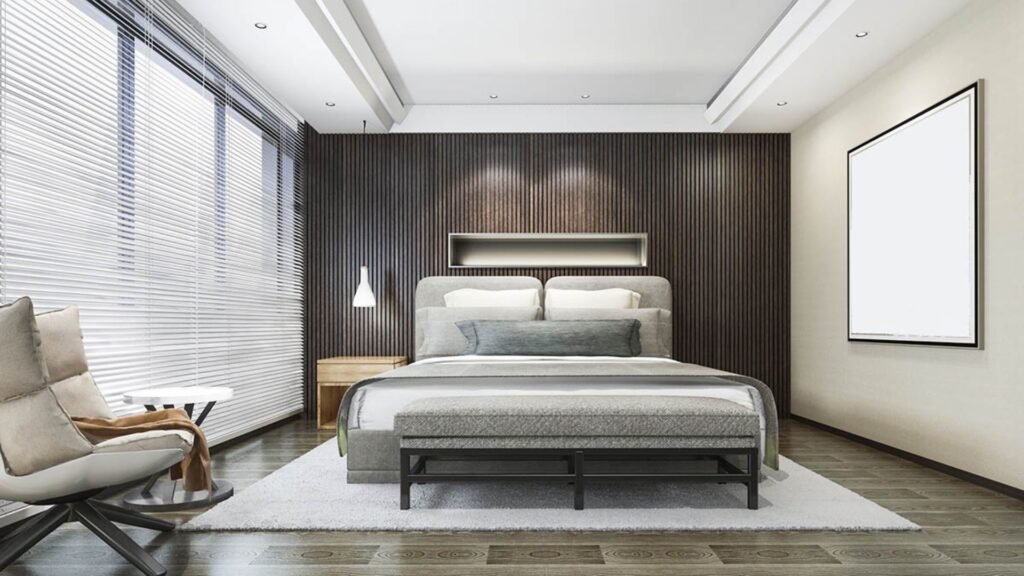
Hidden Or Overlooked Costs
When planning a bedroom renovation, it’s easy to focus only on the big-ticket items, like new flooring, wardrobes, or lighting. But what often catches homeowners off guard are the hidden or overlooked costs that pop up along the way. These smaller expenses can add up quickly and stretch your budget beyond what you expected. Being aware of these costs upfront can help you plan more accurately and avoid financial stress mid-renovation.
Rubbish Removal
Renovations create more waste than most people expect. Old carpet, broken furniture, packaging from new materials, and general debris pile up fast. In New Zealand, rubbish disposal isn’t always included in a contractor’s quote. If you’re managing the project yourself, you’ll likely need to hire a skip bin or make multiple trips to the local refuse station. Prices vary by region, but a small skip bin can cost anywhere from $200 to $400, depending on the size and duration. To keep this cost under control, ask your tradie if disposal is included or arrange a bin before the work starts.
Unexpected Repairs
It’s not uncommon to discover problems once the renovation is underway. Maybe there’s old wiring that doesn’t meet current safety standards, or you uncover water damage behind the walls. These hidden issues can’t be ignored and often require immediate attention to ensure your home is safe and up to code. Repairs like these can add hundreds, or even thousands, of dollars to your total cost. That’s why it’s smart to set aside a contingency budget of at least 10 to 15% of your total spend. You might not need it, but if you do, you’ll be prepared.
Living Arrangements During The Reno
If your bedroom is your only sleeping space or part of a shared living area, you may need to find somewhere else to stay while the work is being done. Even small jobs like sanding floors or painting can create dust, fumes, and noise that make it hard to live in space. This could mean spending a few nights in a hotel, staying with family, or renting short-term accommodation. These costs are often forgotten when planning a renovation, but they can quickly impact your budget. Always factor in the possibility of needing alternative housing, especially for longer or more complex projects.
Taking these hidden costs into account before you start helps you stay in control of your renovation budget. It also makes the experience smoother and less stressful. Being prepared is the difference between a renovation that feels manageable and one that spirals out of control.
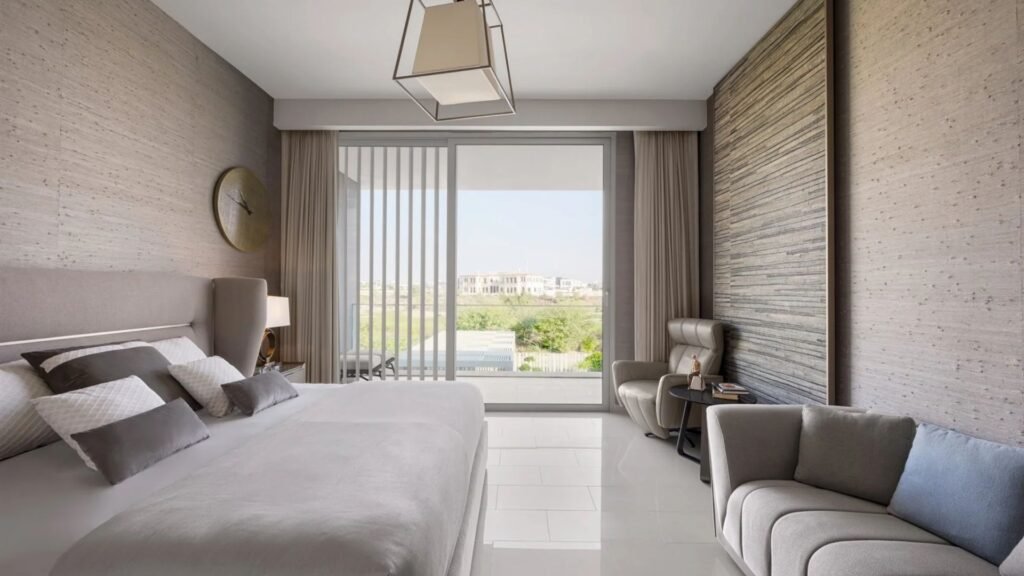
DIY Vs. Hiring A Pro
Renovating your bedroom comes with one big decision, should you do it yourself or hire a professional? The answer depends on your skills, budget, time, and the type of work involved. Each option has its pros and cons, and knowing when to call in the experts can save you money and stress in the long run.
Pros And Cons Of Doing It Yourself
Pros
- Lower Costs: One of the biggest reasons people go the DIY route is to save money. You avoid paying for labour, which can be a large chunk of the renovation budget.
- Full Control: DIY gives you complete control over every decision, from paint colour to finish type.
- Satisfaction: There’s a real sense of pride in completing a renovation project on your own.
Cons
- Time-Consuming: What might take a pro a few days could take you several weekends. If you’re juggling a full-time job, this can drag out the timeline.
- Skill Limitations: Not everything is as simple as it looks on YouTube. Poor workmanship can lead to costly mistakes, especially with electrical, structural, or insulation work.
- Compliance Risks: DIY electrical or structural work can violate building codes or void your home insurance if done incorrectly.
When It’s Best To Leave It To The Experts
There are some jobs where hiring a professional isn’t just the better option, it’s the only safe one.
- Electrical Work: In New Zealand, only licensed electricians can legally handle most electrical tasks. Trying to do it yourself is both unsafe and illegal.
- Structural Changes: Moving walls, modifying windows, or altering ceiling height requires a licensed builder and may need council consent.
- Plastering And Finishing: While not dangerous, achieving a smooth, clean finish with paint and plaster takes years of practice.
- Time-Sensitive Projects: If you’re on a tight deadline, like preparing for a home sale, it makes more sense to hire a professional who can stick to a schedule.
If you’re unsure whether a task is DIY-safe, get a quote from a professional. Many tradies offer free consultations.
Cost Comparison With Real-Life Examples
Let’s compare two bedroom renovation scenarios to show the cost difference:
DIY Example
- Painting walls and ceiling: $200 in paint and tools
- Installing vinyl flooring: $800 materials, DIY labour
- Assembling flat-pack wardrobe: $0 labour
- Total cost: Approx. $1,000
Pro Example
- Professional painting: $1,200
- Flooring supply and install: $1,800
- Custom-built wardrobe installation: $1,500
- Total cost: Approx. $4,500
While the DIY route saved $3,500, the trade-off was over 40 hours of labour and a less polished finish. For someone skilled and with time on hand, it’s a smart move. For others, the peace of mind and quality offered by professionals is worth the cost.
Deciding between DIY and hiring a pro comes down to what you value more, time or money. If your project is simple and you have the right tools and patience, DIY could work. But if it involves structural changes or a tight timeline, bringing in the experts may be the smarter choice.
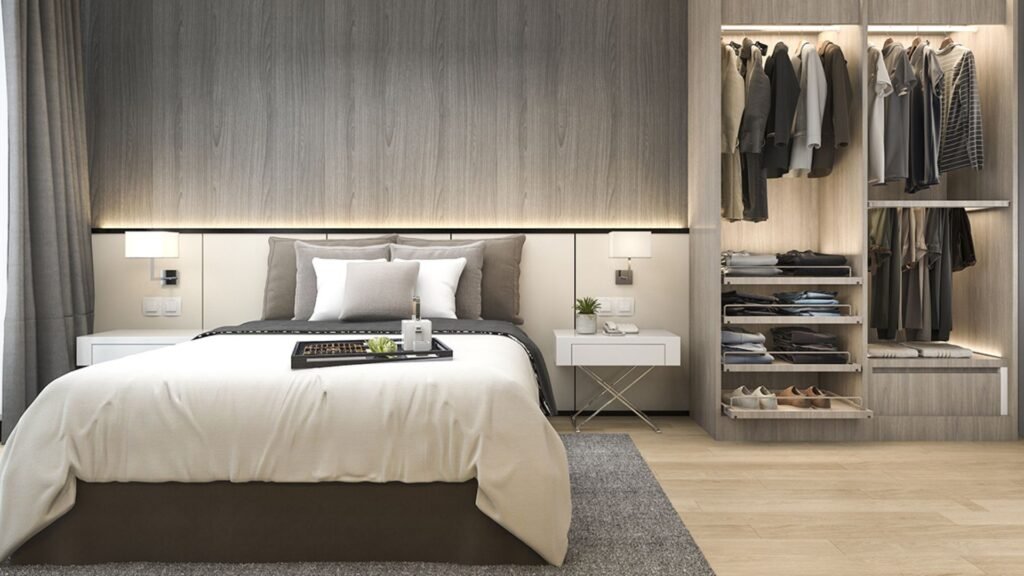
Budgeting Tips
Renovating a bedroom can feel exciting, but without a plan, costs can spiral quickly. Whether you’re aiming for a small upgrade or a full transformation, smart budgeting makes all the difference. Here’s how you can take control of your spending and avoid costly surprises.
Set A Clear Goal Before You Start
Before calling any tradies or buying supplies, figure out exactly what you want to achieve. Are you simply repainting and updating your flooring? Or are you planning to add insulation, rewire lights, and install custom wardrobes?
Write down a list of must-haves and nice-to-haves. This helps you avoid impulse decisions and stay focused. It also ensures you’re comparing apples to apples when getting quotes. Knowing your goal also makes it easier to measure success when the job is done.
Get Multiple Quotes From Tradies
Prices can vary a lot between contractors. One builder might charge twice as much as another for the same job. That’s why it’s essential to get at least three quotes.
When you talk to tradies, ask for a detailed breakdown,labour, materials, and any potential extras. Look for those who are licensed and experienced with residential work in New Zealand. Don’t always go for the cheapest offer. Choose someone who communicates clearly, respects your budget, and understands your vision.
Use Free Online Cost Calculators
Not sure where to begin with estimates? Use an online renovation cost calculator. These tools give you a ballpark figure based on your room size, location, and desired upgrades.
One helpful option for Kiwis is the Refresh Renovations NZ Cost Calculator. It’s easy to use and tailored to local pricing, which makes it more accurate than overseas tools. Just plug in your project details and get a rough estimate in seconds. It won’t replace a real quote from a professional, but it’s a smart starting point.
Plan For A 10–15% Buffer For Surprises
Even with perfect planning, unexpected costs can pop up. Maybe there’s hidden water damage behind a wall. Maybe old wiring needs replacing. Or maybe you fall in love with a light fitting that’s a bit over budget.
Set aside at least 10–15% of your total budget as a buffer. If you don’t use it, great, you’re under budget. But if something unexpected comes up, you won’t have to panic or compromise on quality.
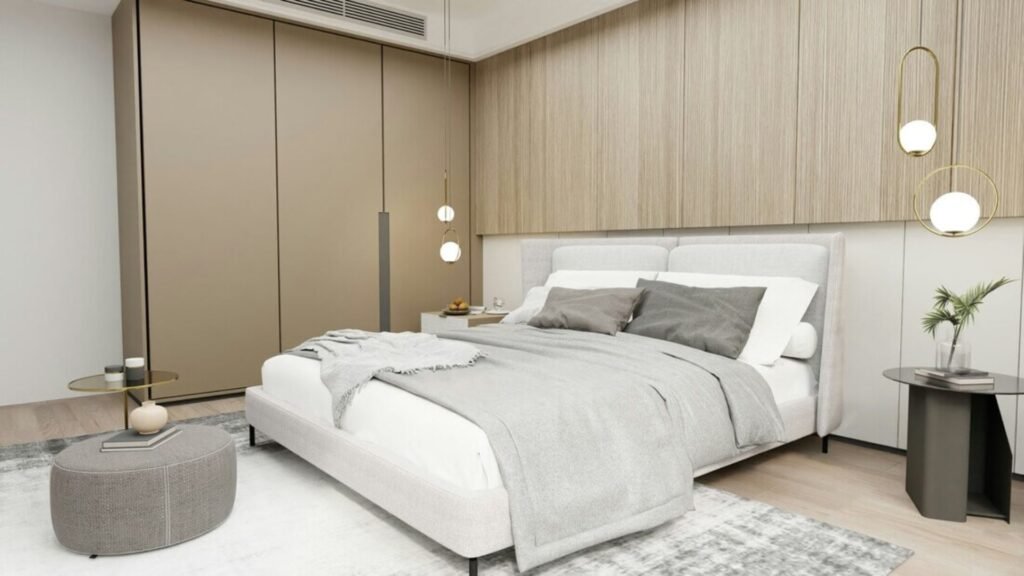
How To Save Money Without Cutting Corners
Renovating your bedroom doesn’t have to drain your savings. With the right approach, you can upgrade your space without sacrificing quality or style. The key is knowing where to spend and where to save. Below are some smart, practical tips that help reduce costs without cutting corners.
Reuse Or Upcycle Furniture
Before rushing to buy new furniture, take a look at what you already have. Can that old bedside table be sanded and painted? Could a dated dresser be refreshed with new handles and a coat of matte paint? Repurposing existing pieces not only saves money but also adds a personal touch to your room. Many homeowners in New Zealand are now choosing to upcycle rather than replace, especially with the rising cost of new furniture. It’s also more eco-friendly, keeping usable items out of landfills.
Shop Local Or Look For Seasonal Discounts
Buying locally made furniture or materials can reduce shipping fees and delays. It also gives you the chance to inspect products in person. Look out for seasonal sales, clearance events, or end-of-line stock at hardware stores and furniture shops. Winter and post-Christmas sales often bring major discounts. You can also check community marketplaces like Trade Me or local Facebook groups for quality secondhand finds.
Do Simple Tasks Yourself (Painting, Demolition)
Labour costs add up fast. If you’re comfortable with basic tasks, doing them yourself can save hundreds. Painting, pulling up carpet, or removing old fittings are all manageable for most DIYers. You don’t need to be a tradie to roll a paintbrush or take down old shelves. Just be sure you’re working within your skill level, leave electrical and structural work to licensed professionals.
Focus On High-Impact Changes Like Lighting And Wall Colour
Sometimes, small changes make the biggest difference. Swapping out harsh overhead lighting for a warm pendant or installing dimmer switches can instantly change the mood of a bedroom. Likewise, painting the walls in a soft, calming tone can transform the feel of the space for a fraction of the cost of a full renovation. These updates are budget-friendly and deliver big visual rewards, making them ideal for anyone looking to refresh a bedroom without spending too much.
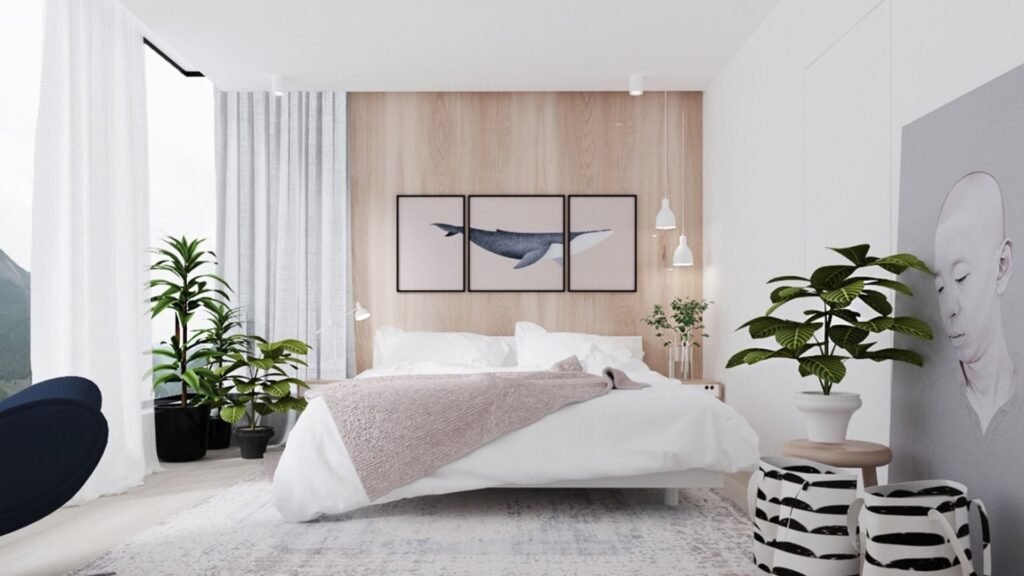
Real Renovation Stories From Kiwi Homeowners
Nothing helps more than hearing from real people who’ve done it themselves. These renovation stories from New Zealand homeowners offer practical insights into what you might expect when updating your bedroom. From budget challenges to creative solutions, these examples reflect everyday experiences, not just glossy magazine makeovers.
Small Budget, Big Results In Palmerston North
- Budget: $6,500
- Timeframe: 2 weeks
- Scope: Paint, carpet, lighting, second-hand furniture
Mark and Jess, a young couple in Palmerston North, decided to refresh their spare bedroom on a tight budget. They painted the walls themselves, chose an affordable but warm grey carpet, and upgraded the lighting to LED. Instead of buying new furniture, they sourced pre-loved pieces online and refurbished a set of drawers with paint and new handles.
- Lesson learned: Starting with a clear plan and sourcing budget-friendly materials can go a long way. “We didn’t need to spend a fortune to make the space feel brand new,” Jess shared.
Master Bedroom Makeover In Christchurch
- Budget: $18,000
- Timeframe: 4 weeks
- Scope: Full reconfiguration, new flooring, custom wardrobe, insulation, lighting
Sophie in Christchurch turned her outdated master bedroom into a modern retreat. She removed an old built-in wardrobe and reconfigured the space to include a walk-in. The room was fully insulated and rewired to support ambient and task lighting. New hardwood floors, blackout curtains, and soft wall tones added warmth and functionality.
- Lesson learned: “The biggest surprise was how much we spent on insulation and electrical work, but it made a massive difference in comfort,” Sophie said. Hiring professionals made the process smoother, but they still managed to stick to their budget by avoiding last-minute changes.
Teen Bedroom Upgrade In Hamilton
- Budget: $9,000
- Timeframe: 3 weeks
- Scope: New layout, built-in desk, wallpaper feature, storage upgrade
When Tom and Renee’s daughter started high school, they wanted to give her a space she could grow into. They added a built-in study nook, replaced the old wardrobe with sliding mirrored doors, and added a wallpaper feature wall. The project stayed on track thanks to clear communication with contractors and pre-planned material selections.
- Lesson learned: Planning around your child’s needs helps prevent future rework. “Our daughter now actually loves doing homework in her room,” Renee said.
These stories show that no two bedroom renovations are the same. Your goals, lifestyle, and budget will shape the outcome, but real results come from planning, flexibility, and being clear on your priorities.
Let us help make your bedroom renovation simple and stress-free. Start by visiting our homepage and exploring your options today.
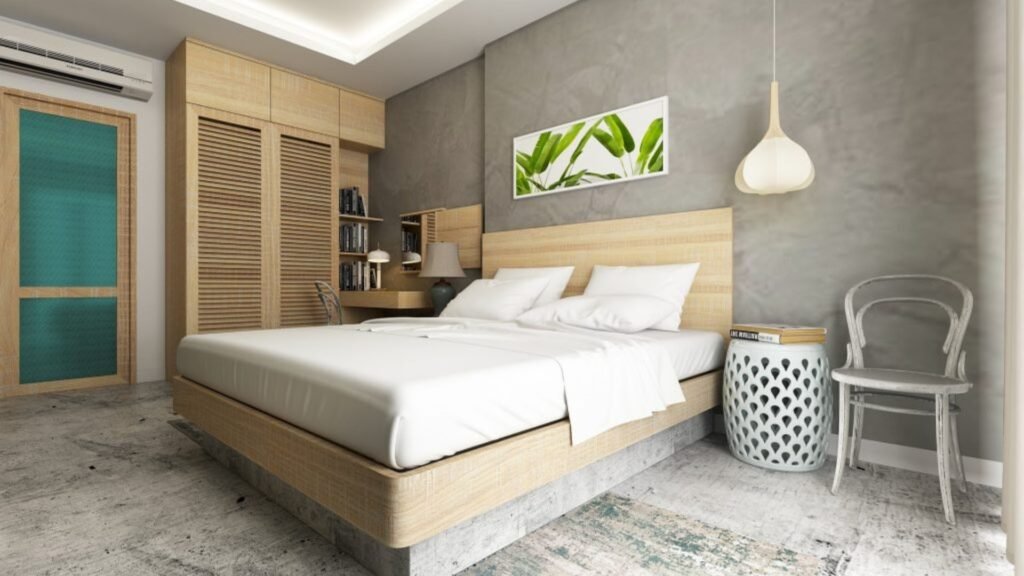
FAQs: About Bedroom Renovation Cost In NZ
How much does a basic bedroom renovation cost in New Zealand?
A basic renovation usually costs between $5,000 and $10,000. This might include painting, replacing flooring, and updating lighting or storage without any major structural changes.
What’s included in a full bedroom renovation?
A full renovation may include structural changes, new insulation, electrical rewiring, custom wardrobes, flooring, windows, and complete redecoration. Costs can range from $15,000 to $25,000 or more depending on the complexity.
Do I need council approval for a bedroom renovation in NZ?
You typically don’t need consent for cosmetic updates, but if you’re altering walls, adding windows, or affecting the structure or wiring significantly, you may need building consent from your local council.
How long does a bedroom renovation take?
Most standard renovations take 1 to 3 weeks. If structural work or custom elements are involved, it can stretch to 4–6 weeks or more depending on availability of contractors and materials.
Can I renovate a bedroom myself to save money?
Yes, you can DIY parts like painting or demo, but tasks involving plumbing, electrical work, or building structure should be done by licensed professionals. Always weigh cost savings against risks and compliance issues.
What affects the final cost of a bedroom renovation?
Key cost factors include room size, material quality, labour rates in your region, complexity of the work, and whether custom features are added. Unexpected repairs and waste removal can also impact the budget.
Is bedroom renovation a good investment for resale value?
Yes. A well-designed and updated bedroom adds comfort and appeal for buyers, which can boost your home’s resale value. Focus on neutral colours, storage, and lighting for the best return.
How can I stick to my bedroom renovation budget?
Start with a clear plan, get multiple quotes, and prioritise essentials. Leave a 10–15% buffer for surprises. Reuse existing furniture and shop around for deals on materials.
What’s the most expensive part of a bedroom renovation?
Structural changes, electrical work, and custom joinery tend to cost the most. Flooring and insulation can also add up depending on material choices.
Are bedroom renovation costs different across NZ regions?
Yes, labour and material costs vary by region. Renovating in Auckland or Wellington usually costs more than in smaller towns due to higher demand and pricing.
Conclusion
You don’t need a huge budget to create a beautiful bedroom that feels fresh, functional, and personal. With a clear plan, realistic expectations, and a bit of research, you can make smart decisions that fit your space and budget. Start by figuring out what matters most to you, whether it’s better storage, a new layout, or just a cleaner look, and build your renovation plan around those goals. Don’t be afraid to ask questions, get quotes, and compare options before making any commitments. Planning ahead helps you avoid costly surprises and keeps the entire process less stressful.

